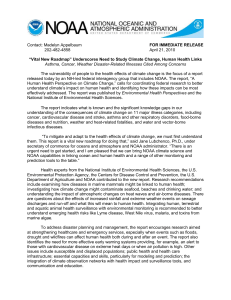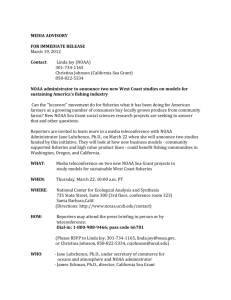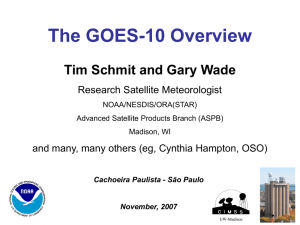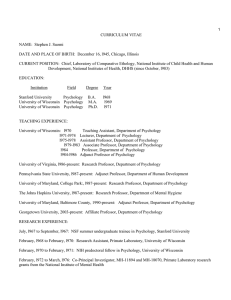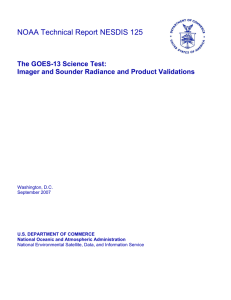Overview of the NOAA Geostationary Program (with a slight Wisconsin bias)
advertisement
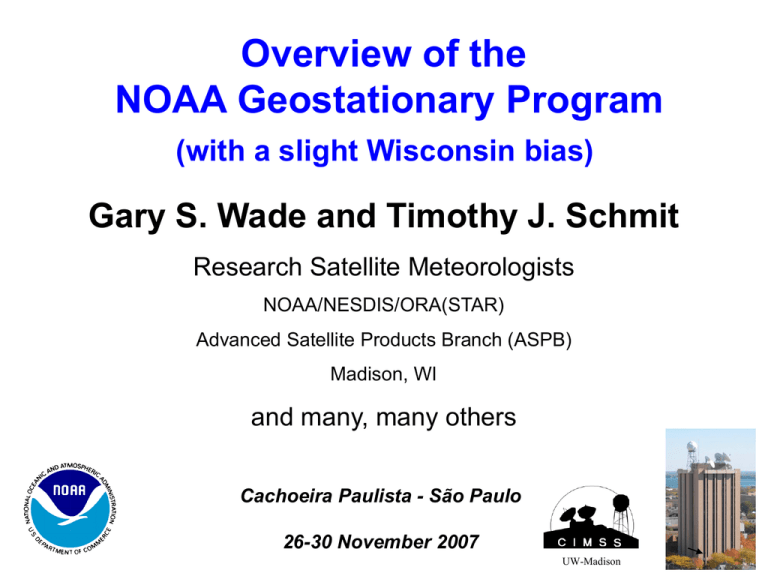
Overview of the
NOAA Geostationary Program
(with a slight Wisconsin bias)
Gary S. Wade and Timothy J. Schmit
Research Satellite Meteorologists
NOAA/NESDIS/ORA(STAR)
Advanced Satellite Products Branch (ASPB)
Madison, WI
and many, many others
Cachoeira Paulista - São Paulo
26-30 November 2007
UW-Madison
Geostationary
Operational
Environmental
Satellite
Polar Orbiting Satellites
Geostationary Satellites
(approximately 1/10th the distance to the moon)
Verner E. Suomi and Robert J. Parent
On 6 December 1966, the Applications Technology
Satellite (ATS-1) was launched. We have had the
benefit of the geostationary perspective for 40 years!
ATS-1's spin scan cloud
camera (UW’s Suomi and
Parent 1968) provided full
disk visible images of the
earth and its cloud cover
every 20 minutes. The spin
scan camera on ATS-1
occurred because of an
extraordinary effort by
Verner Suomi and Homer
Newell, when the satellite
was already well into its
fabrication.
6 December 1966
ATS-III
“the clouds moved not the satellite”
Verner Suomi
From 6 Dec 1966, ATS-1's geostationary spin scan cloud
camera provided full disk visible images of the earth and
its cloud cover every 20 minutes
ATS-III 18Nov1967 15:03Z
Suomi, Parent,
and Fujita
create first color
movie of planet
Earth with
ATS-III pictures
Professor Suomi and McIDAS
(Man computer Interactive Data Access System)
an
1972 – “McIDAS”
2007 – “McIDAS-V”
Including VIS-AD and HYDRA
Water vapor tracked “winds” from Meteosat during
FGGE (the First Global Atmospheric Research
Program (GARP) Global Experiment)
(15 Nov 1979)
The GOES are launched by NASA at Cape
Canaveral, Florida.
The GOES are operated by the National
Oceanic and Atmospheric Administration
(NOAA) at 75° and 135° west longitude .
Physical vertical retrievals from geostationary orbits –
another NOAA and Wisconsin connection
Bill Smith - Suomi student at UW; NOAA researcher, expanding physical
iterative sounding retrievals from POES (HIRS) to GOES/VAS, as NOAA/NESDIS
Development Lab moved to UW-SSEC (mid 1970s); became first director of
CIMSS (early 1980s); went to NASA Langley to continue development of a
geostationary hyper-spectral sounding capability; now at Hampton University as
well as part time at UW-SSEC, still promoting geo hyper-spectral
Kit Hayden – NOAA/NESDIS DL member and retrieval developer (retired)
Paul Menzel – Suomi colleague; multi-spectral remote sensing expert and
teacher at UW-SSEC; senior scientist for NOAA/NESDIS/ORA; first Suomi
Distinguished Professor at UW-AOS
Ma Xa Lin – SSEC geo retrieval algorithm developer (California)
Allen Huang – Suomi student at UW; hyper-spectral remote sensing
advocate and expert extraordinaire
Jun Li – SSEC geo retrieval algorithm developer
GOES Mission History
{from “NOAA GOES-N,O,P – The Next Generation“ (NASA, NOAA)}
GOES Mission History
SMS-1
GOES-1
GOES-4
VAS
(ABLE)
(One sat sys)
GOES-8
GOES-10
GOES-12
(GOES-13)
GOES SOUNDER, 3-axis stab
So Amer
GOES-11
(135W)
GOES-13
(105W)
On-orbit
Storage
GOES-12
(75W)
GOES-10
(60W)
South America
Operational
Operational
GOES Constellation
GOES VAS
12 Infrared Channels (1 Visible Channel)
Filter Wheel Radiometer, operating in Dwell Sound or MSI modes
•Not Operational (precluded by RISOP)
•Venetian Blinding
•Noisy (due to reduced spin budget)
(VAS – VISSR {Visible and Infrared Spin Scan Radiometer} Atmospheric Sounder)
(MSI – Multi-Spectral Imaging
RISOP – Rapid Imaging Special Operation)
The Ups and Downs of Progress
The Ups and Downs of Satellite Advances
Successful
launch
VAS
Demo
VAS
EPAC
NSSFC(KC)
GUFMEX
AVE
geo IR
sounding
1980
1985
1990
GOES-8/M Sounder
18 Infrared Channels (1 Visible Channel)
Filter Wheel Radiometer
• Operational
• Higher Signal-to-Noise
Similar spatial resolutions, but many other differences:
- bit depth, detector type, noise, dwell time, etc.
Note additional cloud-top structure is seen in the GOES-8 data.
Spinner
3-axis Stabilized
Three GOES wide Sounder coverage across the northern mid-latitudes from
Japan to Maine
For GOES-9 (far Pacific), GOES-10 (West US), and GOES-12 (East US),
DPI and imagery include (on left) TPW, band 4 (CO2), and band 11 (H2O)
and (on right) CTP, band 11 window, and band 19 visible.
2003
GOES-11
(135W)
GOES-13
(105W)
On-orbit
Storage
GOES-12
(75W)
GOES-10
(60W)
South America
Operational
Operational
GOES Constellation
GOES Mission History
SMS-1
GOES-1
GOES-4
GOES-8
GOES-10
GOES-12
(GOES-13)
VAS
GOES SOUNDER, 3-axis stab
So Amer
Expectations and reality
GOES-R
GOES-R
GOES-R++
+
GOES-8 +
GOES-4 +
1980
1994
2014
“Sift and Winnow” – a Wisconsin idea
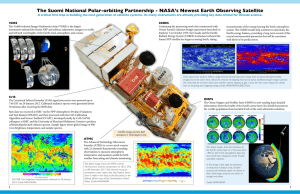

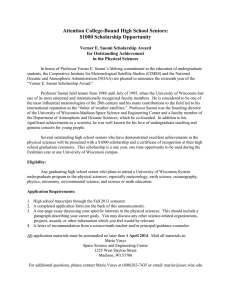
![Eduardo A. Araujo-Pradere [], CIRES, University of Colorado, Solar Minimum](http://s2.studylib.net/store/data/013086460_1-158f16f4991b8d654a2183bbdcda9c6c-300x300.png)

